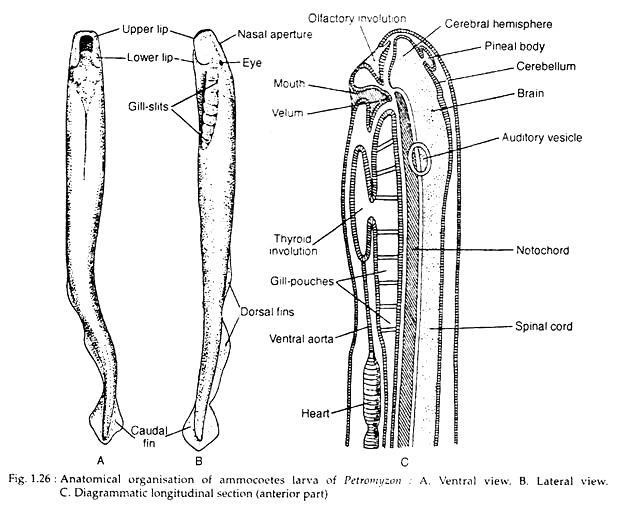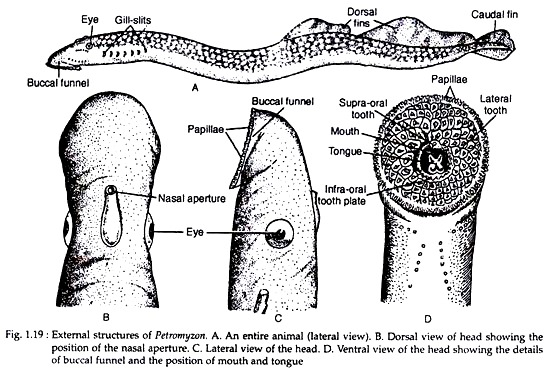In this article we will discuss about characters and classification of craniata.
General Characters of Craniata:
1. Triploblastic animals and are bilaterally symmetrical. The anterior end is called head and posterior end tail.
2. Dorsal nerve cord bulges at anterior end to form brain. The nerve cord lies along dorsal part as spinal cord. The brain is covered by cranium — hence Craniata.
3. Notochord is replaced by vertebral column, composed of vertebrae — hence the name Vertebrata.
ADVERTISEMENTS:
4. Segmented body. External segmentation is inconspicuous but internal segmentation is easily visible.
5. Generally two pairs of lateral jointed appendages are present that help in locomotion in Craniata.
6. In the head region eye, nose and ears are present as sensory organs.
7. Closed type of circulatory system possess heart, artery, vein, capillaries and blood with haemoglobin.
ADVERTISEMENTS:
8. Respiratory organs are either gills or lungs. In some cases skin also helps in respiration in Craniata.
9. Excretory and reproductive systems are closely associated and open externally as urinogenital opening in Craniata.
Classification of Craniata:
Superclass — Agnatha:
These animals are jawless, so they are called Agnatha.
ADVERTISEMENTS:
Class — Cephalaspidomorphi:
General characters:
1. These animals possess head shield over the brain.
2. Single nasal aperture is present at the anterior tip.
According to the scheme of classification proposed by J. Z. Young (1981), four different types of cephalaspidomorphi are recorded from fossils and are grouped in four orders. Among them only order cyclostomata is living till today.
Order — Cyclostomata:
General characters:
1. These are pipe like, elongated animals inhabiting both freshwater and marine water.
ADVERTISEMENTS:
2. Rounded mouth aperture which is of sucking type.
3. Body possess dorsal, ventral and caudal unpaired fins. Scales and paired fins are absent.
4. Only one nasal aperture is present at the anterior end.
5. Cranium and vertebral column are cartilagenous.
6. At the ventrolateral side of the body six to fourteen pairs of gill slits are present. Gill slits open into gill pouch, which perform respiration.
7. Heart composed of a ventricle and an auricle.
8. Single gonad without any gonoduct is present in the abdominal cavity.
9. In some species, a larval stage appears in its life cycle.
Order Cyclostomata is divided into two suborders. One is Petromyzontidae and the other Myxinoidea.
Suborder — Petromyzontidae:
General characters:
1. Aquatic animals, present both in marine and freshwater.
2. Steady tube-like body, with bilobed dorsal fins.
3. Sucker type ventral oral aperture is situated within a buccal funnel. These animals are commonly known as stone sucker.
4. Altogether seven pairs of gill slits are present at both side of the body.
5. The head bears a pair of eyes and a single nasal opening on the dorsal side. Behind the nasal opening there is a gap in the pigment layer of the skin through which the third or pineal eye can be seen as a yellow spot.
6. Sexual dimorphism is present in adults. Gonads are unpaired ridges medial to the mesonephros.
7. In the life-history ammocoetes larval stage is present (Fig. 1.26A & B).
Example:
Petromyzon (Fig. 1.19A), Lampetra (Fig. 1.17).
Suborder — Myxinoidea (Hag fishes):
General characters:
1. All are marine and nocturnal in habit. They live buried in mud or sand and eat polychaetes and other invertebrates.
2. Sub-terminal, ventral mouth aperture is surrounded by three or four pairs of tentacles.
3. Six to fourteen pairs of gill sacs are connected by a common branchial tube and opens to outside by a single opening.
4. The cyst are functionless rudiments.
5. These animals are protandric hermaphrodites.
Examples:
Myxine (Fig. 1.18), Bdellostoma, Polistotrema, Eptatretus.




